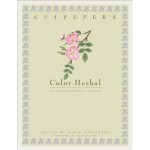 For historians and herbalists alike, this book is informative as well as entertaining. It gives a brief account of almost 400 herbs from the perspective of a 16th century herbalist and provides insight into the medical practices of his time. Additional information on each herb is given on modern day uses of the herbs.
For historians and herbalists alike, this book is informative as well as entertaining. It gives a brief account of almost 400 herbs from the perspective of a 16th century herbalist and provides insight into the medical practices of his time. Additional information on each herb is given on modern day uses of the herbs.
The herbs are listed alphabetically by common name with the botanical name nearby and the entry for each herb fills about one half a page. The entry begins with a paraphrase from Culpeper’s original work and continues with a brief description of the plant, place where it is found, flowering time, astrological association and medicinal use, all based on Culpeper’s work. The final paragraph gives the modern uses of the herb and an illustration of the herb provides information on the characteristics of the plant useful in identification. Culpeper’s description of the many ways the herb was use medicinally is outstanding as they contain interesting comments on medical practices as well as critical comments on other health care providers. Culpeper’s systematic classification of information regarding herbs and medicine was a major step forward in the development of modern pharmaceuticals.
The charm of the entries lie in the information they give of beliefs from the past. Did you know that the berries or roots of the cuckoo-pint (Arum maculatum) beaten with hot ox-dung, can ease the pain of gout when applied to the affected area? Of course, it is also recommended for the treatment of many other ailments including plague, ear aches, and bowel ulcers. Today it is grown as an ornamental.
Culpeper came from a family most famous for Thomas Culpeper, the lover of Catherine Howard, fifth wife of Henry VIII, and the second wife to be executed by him. Nicholas Culpeper, however, was a clergyman’s son and part of the rising middle class in England at a time when the middle class was growing and becoming wealthy. He was educated at Cambridge and became a pharmacist in London and was noted for making medical treatment available to the poor. Like other pharmacists of the day, he believed in the association of disease and astrology. Strange as this may seem, this belief is responsible for many of the herbs recommended to treat various diseases and is the reason why Culpeper’s herbal contained the entry about astrological associations.
If you are interested in herbs or the history of medicine this is a very good read. If you want practical information on using herbs to cure various ailments and diseases, this is not for you. Personally, I love the book for its historical perspective and find it a constant source of fascinating information.
To buy Culpeper’s Color Herbal at Amazon.com click here.
